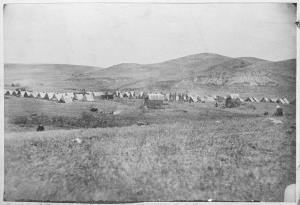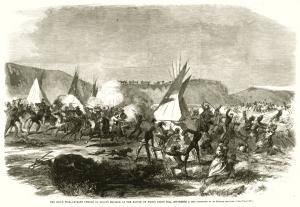 "I hope you will not believe all that is said of 'Sully’s Successful Expedition' against the Sioux. I don’t think he ought to brag of it at all, because it was, what no decent man would have done, he pitched into their camp and just slaughtered them, worse a great deal than what the Indians did in 1862, he killed very few men and took no hostile ones prisoners. . .and now he returns saying that we need fear no more, for he has ‘wiped out all hostile Indians from Dakota.’ If he had killed men instead of women & children, then it would have been a success, and the worse of it, they had no hostile intention whatever, the Nebraska 2nd pitched into them without orders, while the Iowa 6th were shaking hands with them on one side, they even shot their own men."
"I hope you will not believe all that is said of 'Sully’s Successful Expedition' against the Sioux. I don’t think he ought to brag of it at all, because it was, what no decent man would have done, he pitched into their camp and just slaughtered them, worse a great deal than what the Indians did in 1862, he killed very few men and took no hostile ones prisoners. . .and now he returns saying that we need fear no more, for he has ‘wiped out all hostile Indians from Dakota.’ If he had killed men instead of women & children, then it would have been a success, and the worse of it, they had no hostile intention whatever, the Nebraska 2nd pitched into them without orders, while the Iowa 6th were shaking hands with them on one side, they even shot their own men."
Samuel Brown, a language interpreter during Sully's expedition, 1863
The Battle of Whitestone Hill
 On September 3, 1863, the Second Nebraska Cavalry, the Sixth Iowa Cavalry, and one company of the Seventh Iowa Cavalry, under the command of Brig. Gen. Alfred Sully, attacked a large Native American encampment in what is now extreme south-central North Dakota. The location is referred to as the Whitestone Hill battlefield, but in tribal memory it is the Whitestone Hill massacre site. The attack resulted in more Native casualties than any other conflict in North Dakota, with losses on a larger scale that those at Wounded Knee in 1890. The oral history of Whitestone Hill tells us that many women and children were killed while the men were out hunting.
On September 3, 1863, the Second Nebraska Cavalry, the Sixth Iowa Cavalry, and one company of the Seventh Iowa Cavalry, under the command of Brig. Gen. Alfred Sully, attacked a large Native American encampment in what is now extreme south-central North Dakota. The location is referred to as the Whitestone Hill battlefield, but in tribal memory it is the Whitestone Hill massacre site. The attack resulted in more Native casualties than any other conflict in North Dakota, with losses on a larger scale that those at Wounded Knee in 1890. The oral history of Whitestone Hill tells us that many women and children were killed while the men were out hunting.
The Battle of Killdeer Mountain (also known as the Battle of Tahkahokuty Mountain)
This battle took place during Brig. Gen. Alfred Sully’s expedition against the Dakota in Dakota Territory on June 28, 1864. The location of the battleground is in modern Dunn County, North Dakota. With more than 4,000 soldiers involved, Sully’s expedition was the largest ever carried out by the U.S. army against Indians. The Indians in the encampment consisted mostly of Lakota (Teton) from the Hunkpapa, Sihasapa, Miniconjou, and Sans Arc bands, plus Yanktonais and a few Santees, of which about 40 were killed (though estimates go into the hundreds). Sully lost only about 10 men. The Indians in the encampment were armed mostly with bows and arrows and a few short-range muskets and shotgun. Most of them, especially the Tetons, had never been engaged in hostilities with U.S. forces before this encounter.
The day after the battle Sully detailed 700 men to destroy the abandoned encampment. This included tipis, large supplies of food, and thousands of dogs. A few people who were left behind in the camp, including children, were killed by Sully's men.
Most of the Dakota scattered through the Badlands to the west of Killdeer Mountain, but some remained near Sully. Several waved a white flag and requested talks but they were fired on by soldiers and fled. Though he was short on supplies, Sully decided to continue his pursuit of the Dakota and instigated the Battle of the Badlands.